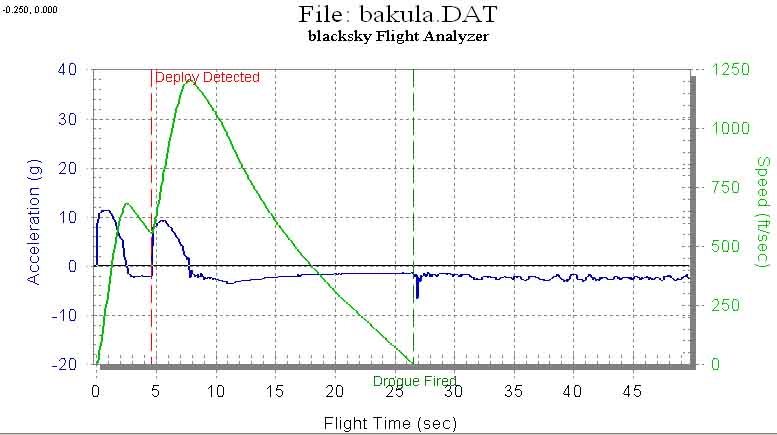
Flutterly amazing ride!
At XPRS III Peter Clay's U.S.S. Bakula took aloft an Aiptek DV4500 and captured some pretty cool fin flutter footage.

Here are a couple of frames from the video where the fins wave like flags.
The video has inspired many theories as to what was captured but these are the only known facts.
U.S.S. BAKULA Fin Flutter Videos
If you like here are Quicktime (Mpeg4) files you can use keyboard arrow keys to step through the frames
Note: the two other trails you see in the full length video are from two ARLISS birds, the three drag raced but the Ms came up to pressure before the K550.


NOTE: 2010 - found the proper term and explination for what was captured in this video - Rolling Shutter
Rolling shutter is an effect caused by the shutter (or effective shutter in cases of cameras with no physical shutter) in any camera rolling or moving across the exposable image area instead of exposing the image area all at the same time
But for your amusement here are - "(2005) Theories Theories Theories - What the hell got captured on that video??"
Note: This is only a small portion of the chatter this video generated.
Bob Krech of Physical Sciences Inc.
I showed the video to our best design and test engineer. He said "Yep. I've seen that kind of motion before in vibration tests of fiberglass tubes. Those fins are toast. You won't see much visual damage, and they may look fine, but if you do an ultrasonic test you will see that the glass fibers are broken and fins have lost most of their mechanical strength. ...."
So I went to the PML website to check out the PLM Quantum Leap 3K and was surprised to find that it has 1/16" G-10 fins. No wonder it flutters. For their size, the fins are not stiff enough for those speeds. I didn't do any calculations, but I'm guessing you need at least 3/32" or more likely 1/8" G-10 fins for this rocket to insure a non-flutter flight of the motors that could likely to be flown with the kit. I don't know what this particular rocket had for fins, but PML recommends strengthening the airframe for the motor combo used in this flight. This includes increasing the fin thickness to 3/32" however this may be inadequate if indeed these modification were indeed done to the rocket in the video.
The sustainer had a 2 Hz roll rate during the flutter which indicates that the fins are not parallel with the centerline of the airframe, and are operating at a non-zero angle of attack. This probably enhances the onset of the flutter.
So I am now convinced that you are seeing real flutter and not an optical effect due to index of refraction gradients in the transonic flow. This should be an eye opener to high performance rocket designers, and might suggest that a review of existing high performance kits be undertaken to insure that the fin stiffness is adequate for the intended flight Mach range. The fins on this particular rocket were inadequate and the rocket is likely to fail on a subsequent flight unless the present fins are removed and replaced by much stiffer fins.
I find it hard to believe that this is fin flutter.
However, I find it even harder to believe that it is not. Therefor, it is.
Case point 1) Light/heat-wave refraction or mach barrier theory: If we are being fooled by the video image, the image around the fins would also be distorted, and examination of several frames shows that is not the case. The smoke trails and reflections are valid. I think the video frames are valid. We are seeing time slices of fin position dictated by the recording frame rate and shutter speed of the camera. The quickest way I can explain this is by watching the wagon wheels in an old western movie. As the wagon slows or speeds up, the wheel spokes seem to change the direction in which they rotate. This is an artifact of the shutter speed of the movie camera and the speed of the rotating spokes. However, the background seen through the wheel spokes is unaffected.
What the video has caught is a modal resonance of the fins. a first, second, or third multiple of the fins natural vibrational frequency. Fins fail (as also a certain bridge in the Tacoma Narrows) when the force of the wind rushing past them excite and amplify a certain natural frequency. If the amplitude and duration is sufficient, they snap off, or cause sufficient disruption to the attitude of the airframe where they are blown off sideways.
I have studied and conducted structural shock and vibration analysis both on shakers with accelerometers and viewed with stroboscopes, and FEA simulation to recognize classic modal displacement. What amazes me most, is the utter shear coincidence that the video camera's frame rate just happened to catch a vibrational mode. This is a kin to pulling just the right tuning fork out of your pocket.
Whether or not most of our rockets go through this, or this one was just real lucky to survive is the question that intrigues me now. The fins on this rocket should be examined for micro cracks. Another interesting question is; did the fins heat up and become softer? Does anyone know the structure and lay-up of the rocket and fins in this video?
Gabe